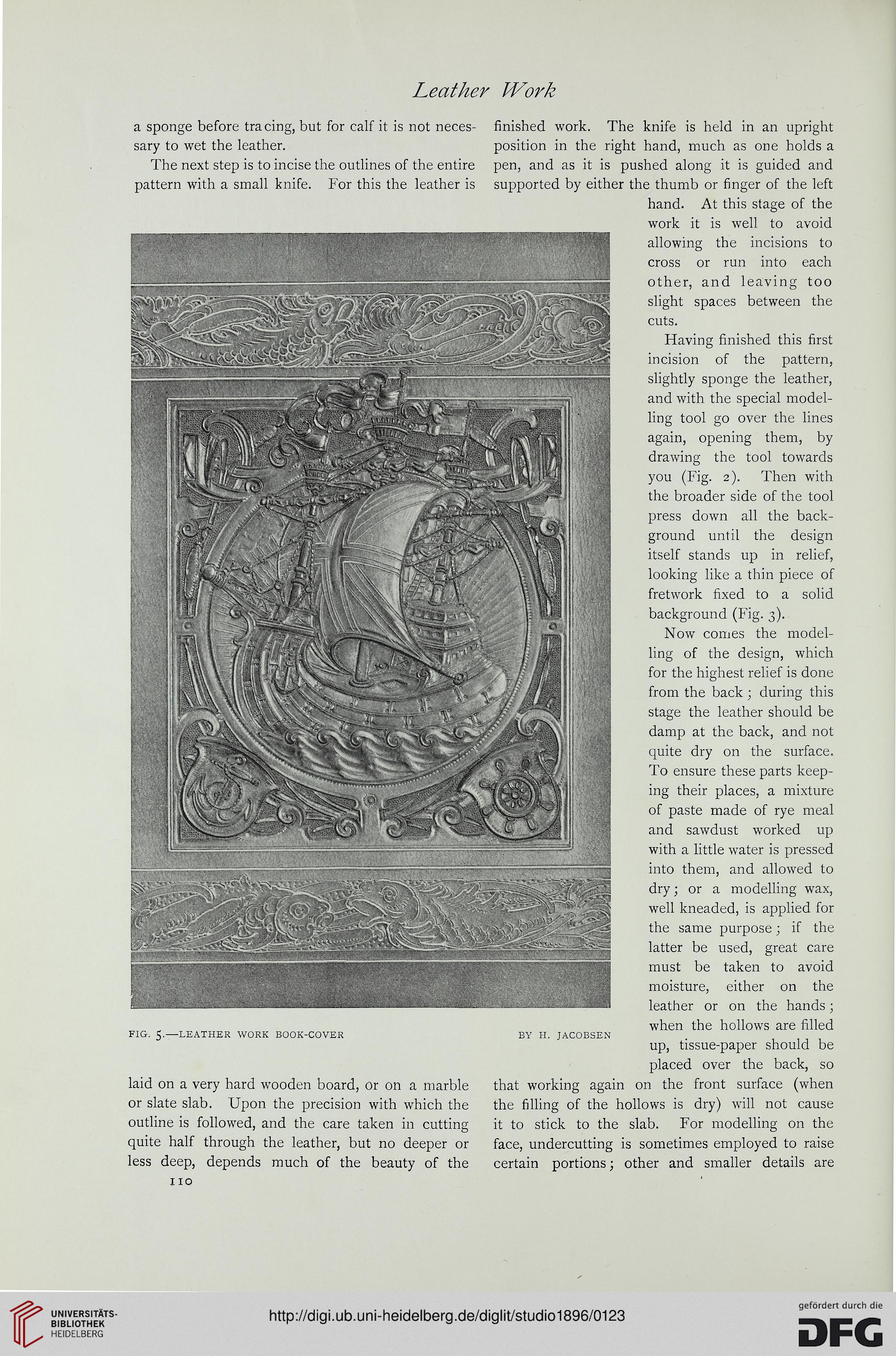Leather Work
a sponge before tracing, but for calf it is not neces- finished work. The knife is held in an upright
sary to wet the leather. position in the right hand, much as one holds a
The next step is to incise the outlines of the entire pen, and as it is pushed along it is guided and
pattern with a small knife. For this the leather is supported by either the thumb or finger of the left
hand. At this stage of the
work it is well to avoid
allowing the incisions to
cross or run into each
other, and leaving too
slight spaces between the
cuts.
Having finished this first
incision of the pattern,
slightly sponge the leather,
and with the special model-
ling tool go over the lines
again, opening them, by
drawing the tool towards
you (Fig. 2). Then with
the broader side of the tool
press down all the back-
ground until the design
itself stands up in relief,
looking like a thin piece of
fretwork fixed to a solid
background (Fig. 3).
Now comes the model-
ling of the design, which
for the highest relief is done
from the back ; during this
stage the leather should be
damp at the back, and not
quite dry on the surface.
To ensure these parts keep-
ing their places, a mixture
of paste made of rye meal
and sawdust worked up
with a little water is pressed
into them, and allowed to
dry; or a modelling wax,
well kneaded, is applied for
the same purpose; if the
latter be used, great care
must be taken to avoid
moisture, either on the
leather or on the hands;
when the hollows are filled
FIG. 5.—LEATHER WORK BOOK-COVER BY H. JACOBSEN
up, tissue-paper should be
placed over the back, so
laid on a very hard wooden board, or on a marble that working again on the front surface (when
or slate slab. Upon the precision with which the the filling of the hollows is dry) will not cause
outline is followed, and the care taken in cutting it to stick to the slab. For modelling on the
quite half through the leather, but no deeper or face, undercutting is sometimes employed to raise
less deep, depends much of the beauty of the certain portions; other and smaller details are
110
a sponge before tracing, but for calf it is not neces- finished work. The knife is held in an upright
sary to wet the leather. position in the right hand, much as one holds a
The next step is to incise the outlines of the entire pen, and as it is pushed along it is guided and
pattern with a small knife. For this the leather is supported by either the thumb or finger of the left
hand. At this stage of the
work it is well to avoid
allowing the incisions to
cross or run into each
other, and leaving too
slight spaces between the
cuts.
Having finished this first
incision of the pattern,
slightly sponge the leather,
and with the special model-
ling tool go over the lines
again, opening them, by
drawing the tool towards
you (Fig. 2). Then with
the broader side of the tool
press down all the back-
ground until the design
itself stands up in relief,
looking like a thin piece of
fretwork fixed to a solid
background (Fig. 3).
Now comes the model-
ling of the design, which
for the highest relief is done
from the back ; during this
stage the leather should be
damp at the back, and not
quite dry on the surface.
To ensure these parts keep-
ing their places, a mixture
of paste made of rye meal
and sawdust worked up
with a little water is pressed
into them, and allowed to
dry; or a modelling wax,
well kneaded, is applied for
the same purpose; if the
latter be used, great care
must be taken to avoid
moisture, either on the
leather or on the hands;
when the hollows are filled
FIG. 5.—LEATHER WORK BOOK-COVER BY H. JACOBSEN
up, tissue-paper should be
placed over the back, so
laid on a very hard wooden board, or on a marble that working again on the front surface (when
or slate slab. Upon the precision with which the the filling of the hollows is dry) will not cause
outline is followed, and the care taken in cutting it to stick to the slab. For modelling on the
quite half through the leather, but no deeper or face, undercutting is sometimes employed to raise
less deep, depends much of the beauty of the certain portions; other and smaller details are
110





